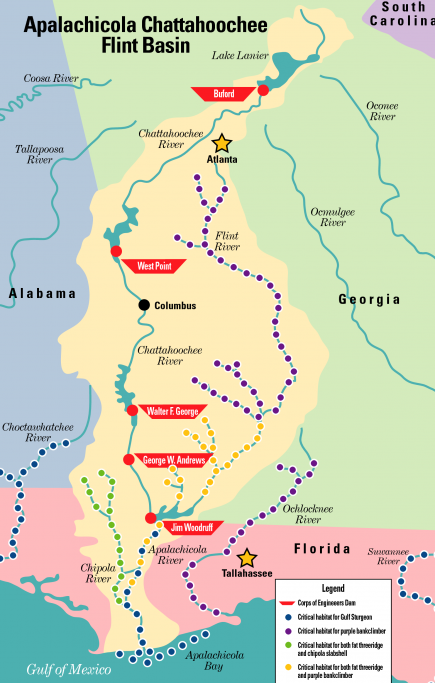Will the New Year bring sustainable water management to the Southeast?
In 2003, I moved from Indiana to Georgia to begin a new job as Executive Director of Georgia River Network. When I arrived in the Peach State, the Tri-State Water War between Georgia, Alabama, and Florida had already been going on for over 13 years. Now, over 13 years later, this war over water still continues.

Source: US Fish and Wildlife Service
In a nutshell, the Tri-State Water War is a long-term legal battle between the states of Georgia, Alabama and Florida over the use and management of water in the Chattahoochee, Flint and Apalachicola rivers – or what is often referred to as the ACF River Basin. Florida and Alabama contend that Georgia uses more than its fair share of water from these rivers that all three states rely upon, Georgia disagrees.
The Chattahoochee River begins in the mountains north of Atlanta and supplies a lot of water to growing metro-Atlanta. It also has several large main-stem reservoirs that the Army of Corps of Engineers manage and operate via a Water Control Manual that was very outdated and just recently updated. South of Atlanta, the Chattahoochee River flows along Alabama and Georgia’s shared border.
The Flint River begins underneath Atlanta’s Hartsfield Jackson International airport, and it too provides a lot of water for metro-Atlanta. As the Flint flows south it is also heavily relied upon to irrigate hundreds of thousands of acres of South Georgia agricultural land to grow peanuts, cotton, corn and other crops. The Flint River has no main-stem Army Corps of Engineers reservoirs that store water in the basin.
At the Florida state line, the Flint and Chattahoochee converge to form the Apalachicola River which flows through the Florida Panhandle to Apalachicola Bay in the Gulf of Mexico. The Apalachicola River is home to endangered fish and mussels and supplies the freshwater needed to support the Apalachicola Bay oyster fishery.
Unfortunately, the Tri-State Water Wars are in the news again as a Special Master appointed by the U.S. Supreme Court considers arguments from Georgia and Florida in the latest round of the battle. This time, the Special Master will make recommendations to the US Supreme Court which will make a determination on if, and how, the ACF’s water should be apportioned.
It’s unfortunate because, first, Georgia alone has spent over $24 million dollars just THIS YEAR on legal fees to support a team of over 70 lawyers to fight this current battle. The state has spent over $40 million on legal fees over the course of the decades-long Water War. You can’t help but wonder what we might have achieved if that money had been spent on water efficiency, conservation and other water management tools.
Second, the ACF Stakeholders, a diverse group of stakeholders in the ACF Basin, came together and worked for several years to come up with a Sustainable Water Management Plan, backed by data and science, on how the waters of these river basins could be equitably shared and adaptably managed to meet the needs of all. Those recommendations have been largely ignored by the states who decided battle it out in court this fall instead of coming to an agreement on how to share the water.
This most recent court case started at the end of October and concluded at the beginning of December. The Special Master overseeing the case will make his ruling sometime in the next few weeks. As we wait to hear the Special Master’s recommendation to the U.S. Supreme Court, let’s hope that, going forward, we will see more investment in sustainable water management and policy, and less on lawyers and court battles.
When it comes to sustainable water management and policy, our latest report, “Protecting and Restoring Flows in Our Southeastern Rivers: A Synthesis of State Policies for Water Security and Sustainability,” can help. The report was created to support states in protecting and restoring flows in their rivers by offering information, alternatives, and models of state policies that result in water security and sustainability, including:
- Water budgets– States can adopt policies to gather and utilize information on how much water is being used and returned to river basins to inform their water management decisions. River Network’s online science module on Environmental Flows and Water Security also has several components focused on understanding and developing water budgets.
- Managing supply – States can adopt policies aimed at sustainable management of water supply and river flows, including water withdrawal permitting and tracking, interbasin transfer evaluation and water planning.
- Flow protection – States can develop science-based environmental flow criteria as well as adopt mechanisms or policies to apply the criteria, including water allocation and withdrawal permitting policy and water quality standards.
- Reducing Demand – States can adopt policies to advance water conservation and efficiency, including managing water loss and integrating conservation and efficiency into withdrawal requirements.
- The Built Environment – States can adopt policies to reduce the demand for water and create more natural systems in the “built environment” that contribute to and replenish our streams and rivers. One example is going above and beyond the federal requirements and requiring more water efficient fixtures and appliances. Another is to use stormwater permitting to encourage or require the development of land to more closely mimic natural landscapes and hydrology by retaining certain amounts of water on-site.
As we head into the New Year, hopefully the states will resolve to achieve more sustainable water policy and less legal wrangling. It will benefit us all.




